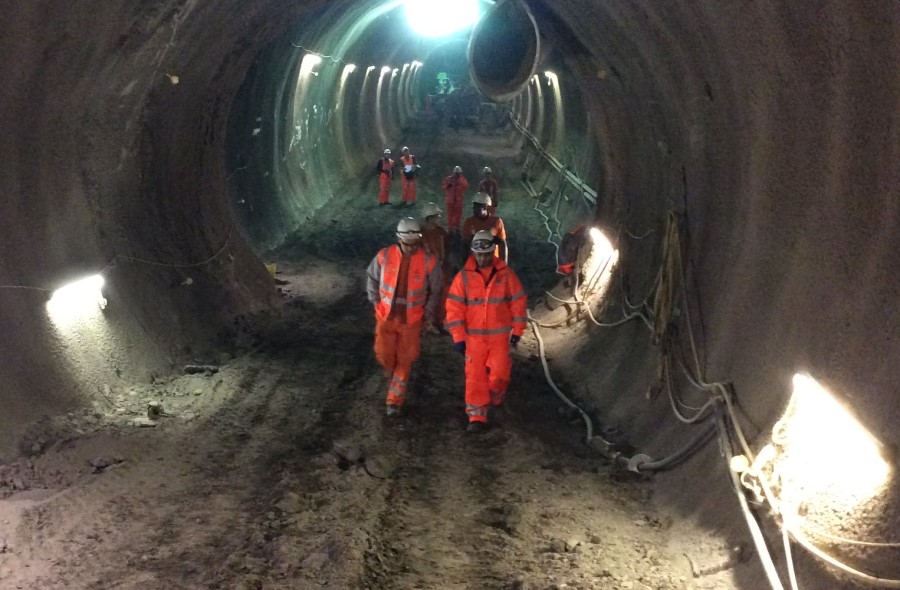Calvin Jones, Professor of Economics at Cardiff Business School, critiques current discounting practices used to evaluate long-term investments, arguing that they systematically undervalue future benefits. By advocating for a revised approach that considers ecological and social factors, Calvin suggests using a lower discount rate to prioritise sustainability and equity.
The future… is another country?
Go find a kid. Preferably one you know, at least vaguely. A cute one would be mint.
Sit down said kid. Explain (possibly via the medium of TikTok) how you think they are great, honestly, but frankly, their future dreams are not quite as cool or important as the ability of you, yourself, the grown-up, to have the resources and ability to do what you want to do right now. Oh, and if said kid wants eventually to have their own kids (and at this point, my 12-year-old’s eyes would be rolling like pinwheels), then like, we really don’t care about them.
Sounds ludicrous, doesn’t it? Especially in a world where most politicians do ten minutes on sustainable development and the climate emergency every time the fridge light goes on, and especially from where I’m writing – a Wales where we actually have a law to protect future generations.
Yet this is what we do in practice every time we build or invest in anything for the long term – not just in Wales and the UK, but pretty much everywhere in the world. We value, for notionally good reasons, future well-being less than today’s.

This is because almost all organisations, public and private, deliberately and mathematically downplay the future benefits and costs of today’s investments using something called the discount rate. This discount rate has, for generations, been systematically downgrading the wellbeing of future-us – and future-us’s children and grandchildren. For reasons that are superficially sensible, but, when you start to think about them in today’s context, much harder to justify.
Buckle up! Some very quick maths
Iesu Mawr (Great Jesus) Calvin, what does this mean in practice? I hear you ask.
Well, let’s take a very simple numerical example J.
…
…
…
OK, for those of you left, let’s imagine a simple hypothetical. Cantre’r Gwaelod Borough Council’s new wholly-owned nuclear energy company Glow Yfory is considering building a new power station. The Gwynfor Evans Community Nuclear Reactor will cost £1.5bn right now, and after completion by the end of 2030 (look, I said it was hypothetical) will produce £100m worth of electricity each year for 30 years, before costless decommissioning in 2061 (look, I said it was hypo… never mind).
On the face of it, this is a no-brainer, right? Assuming no change in the real cost of electricity, and with our discounting accounting for the impact of inflation, we get £3bn (30 years x £100m) of electricity for only £1.5bn up front. Double your money! Sorted! Bang it through Nye3000 (the social partnership procurement AI) and away to the pub.
But this is where discounting comes in. Cantre’r doesn’t have a cool £1.5bn lying around, so the money will come from via the ‘Corddi Cardi Bay’ city deal; administered by Crown Estate but ultimately Treasury money. And the Treasury business case model – adopted across the UK of course – uses a discount rate of 3.5% – the amount at which we depreciate future benefits for every year that passes.
So every year that electricity generation marches into the future, we must value its benefits less and less; for three decades every 3.5% annual reduction building on the one before, Optimus Prime shrinking to a little fizzing tin soldier. Total power plant output produced for 2031, worth £100m in today’s market, we value at £79m (remember we’re ignoring inflation and electricity price changes here). Power generation in 2044 is valued at only half that of today.
By the magic year of 2050, £100m of today’s electricity is valued at £41m in our Treasury business case, and by the time decommissioning rolls around, about £30m.
And the key outcome here? Adding up these business case values for electricity generation each year, our much-vaunted new reactor only delivers. £1.499bn of ‘net present value (NVP)’, NPV for our £1.5bn investment. A negative cost-benefit ratio. Time to down our pints and get back to the office 🙁 .
It’s immediately clear that the application of a discount rate determines not only whether projects are funded (a positive NPV is required for private as well as public investments), but also which of any number of possible projects are funded using scarce resources. It does not take a prestigious MBA to realise that a high discount rate will choke off more projects– and the higher the discount rate, the more such business cases will favour investments that deliver benefits quickly – or shunt costs into the far future.

Where does this discount rate come from then?
Ramsey, F. P. “A Mathematical Theory of Saving.” The Economic Journal 38, no. 152 (1928): 543–59.
(Right, that’s the academic stuff done).
Poor tragic genius Frank Ramsey, mentored by Keynes, dead at 26, never lived to see his theoretical model of optimal saving developed by others into an approach that would shape the world. Application of his conceptual approach gives us the social discount rate – that is relevant for public projects – which assigns lower values to future consumption (hence, but see later caveats wellbeing) for several and varying reasons. For HM Treasury, there are three elements.
Firstly, HM Treasury (HMT) (and all discount rates) assume that the economy grows over the long term. If, as Ramsey put it “the probability [is] that future inventions and improvements in organisation are likely to make income obtainable with less sacrifice than at present”, then there is no need to worry too much about future people. Their massive economy can deliver current levels of benefit at lower relative cost than today’s economy, and so our investment in (say) nuclear power or climate adaptation now implies a far greater sacrifice than required by future-us for the same benefits. Discount rates adjust for this future capacity. This material improvement is operationalised by HM Treasury by assuming a GDP growth rate of 2.0% per annum.
Secondly, there is a risk component, L, which basically says, look, another dinosaur killer might arrive in the next decade. Or an inconvenient zombie epidemic means society falls apart. Or (more prosaically) some unthinkable new whizz-bang technology will mean that they can probably conjure electricity out of the air or sea like magic (imagine!), meaning the Gwynfor Evans kilowatts go unused and our sacrifice of £1.5bn in 2024 consumption is unrewarded. HM Treasury currently sums the risk of such systematic and project risks to about 1% each year. Which is… encouraging.
A third element, and to my mind the most contentious is δ (sorry), delta – an allowance for pure time preference, characterised by the desire to have nice things now. I mean, this is not a rocket science concept – it is literally called impatience in the economic literature and its consequence is that future interests (e.g., of the next generations) are systematically and structurally overlooked via a ‘defective telescope’ approach to the future has been recognised for a century, by economists and philosophers as well-known to you all as Marshall, Bentham and (stick with me) Pigou. In his review of the Economics of Climate Change in 2006, Nick Stern suggested that we should not use time preference at all. It stays dependably in the HMT Green Book at 0.5% per annum meaning (ignoring µ, and you have my permission):
Social discount rate = (g + L + δ) = 2.0% + 1.0% + 0.5% = 3.5%
All well and… good. Or at least explicable. But discounting the future in this way relies on a whole host of pretty sketchy assumptions… and as the greatest managerial practitioner ever born knew well if you assume you make an ass of u and me.

Discounting discounting
Let’s start at the top. With the largest element of HMT’s discount-rate pie, the assumption of 2% economic growth per annum – and, reading between Green Book lines, forever. This is already higher than the average of forecasters’ estimates of long-run UK growth reported in the last review of HMT discount factors in 2018 –1.7%, with this figure incorporating the great stagflation after the great financial crisis, but estimated pre-COVID, pre-Ukraine… i.e. from back when the world didn’t look like the immediate prequel to Fallout. Of course, you can be pretty sure none of the economists polled took seriously the prospect that economic growth might be semi-permanently stymied by the four inter-related apocalyptic horsepeople of runaway climate change, ecological collapse, technology-driven hyper-inequality and conflict. Other horsepeople are available to taste. Far-right driven societal unrest; horrific (on a personal level at least) demographic change over upcoming decades; steep increases in chronic health conditions and economic inactivity in developed countries; pandemics (seriously here, do not drink unpasteurised milk); a new Coldplay album… but they almost all speak to a systematic crisis of global capitalism, consequent on its inability to deliver prosperity commensurate with hard planetary limits, wide inclusion, and social and spatial justice. There will never be enough sustainable aviation fuel to fly over this car crash.
Any one of these headwinds can have significant impacts on economic growth (as Japan has discovered over recent decades as it has aged). Taken all together, the prospect of 2% annual GDP growth by 2050 seems… fanciful. Without this growth, the future (with all its looming problems) is harder to manage. Our current sunny view of our future-selves ability to draw wellbeing from an ever-growing pie looks negligent. If not downright selfish.
Whilst growth is the biggest statistical portion of the discount pie, there is a bigger, albeit conceptual, elephant in the room. As befits every bonkers idea arising out of economics ever, discounting assumes consumption equals wellbeing (or, in econospeak, utility). Hence, if we set aside 5% of our current income to invest for the future, we today are 5% worse off. The conceptualisation of investment as one-to-one ‘negative current wellbeing’ makes little sense for a couple of reasons (and for one extra reason from the perspective of my uncle Russ, who gets paid to wield a shovel on new roads and buildings).
Firstly, we know that (material, economic) consumption is not linearly correlated with wellbeing, especially for the richer in societies. You take a billion quid away from Sir Jim Ratcliffe (net worth: £29bn) to invest in a new railway and you can be damn sure it will have far less than, random example, clamping down on disability benefits to save the same billion. The implications of inequality for wellbeing in investment appraisal have been recognised in Spain, which lowered its discount rate following evidence that society was becoming more equal. Adjusting for inequality might reduce the discount rate by as much as one percentage point in the UK and US. For a government to ignore the impact of inequality – now or projected – on the returns to investment is one thing. But it’s a bit rich (sic) to base an entire investment approach on notionally optimising societal utility over time, whilst every political party studiously ignores the possibility of significantly increasing societal utility now and in the future through, for example, funding investment through wealth taxes – or, perhaps more politically palatably, applying differential discount rates depending on whether investments have differential impacts across income groups.
Secondly, consumption in the UK is, right now, deeply dysfunctional. Rather than the rational homo economicus that underpins ‘economic theory (with limited exceptions), our consumption behaviours are in many respects self-damaging, for example through excess consumption leads to chronic debt, health issues, addiction, burnout, and more ruinously expensive guitars than one can reasonably play for an increasing proportion of society – and all underpinned by an economic model that is gleefully boiling the planet and lumping significant social and ecological costs on those doing very little of the actual consuming.
Hell, taking money (but clearly, not guitars) away from us idiots would be a blessing, especially if the resultant investments were structured in a way that would reduce environmental damage in both development and operational phases, and be targeted at improving societal cohesion in the long term. This is especially true if you have optimism about the future – if you think ‘us-then’ will be able and willing to consume in fairer, better, less damaging ways than ‘us-now’. And if you don’t… well, well done for reading this far without giving in to the urge to put a bucket over your head. Unless of course, you have. HELLO IN THERE!!

What is a responsible government to do?
No—one thinks very much about the discount rate. I find it a bit boring and I’m an economist for goodness sake! But discount rates and factors are important: there is arguably not much that is more important than the rules governments set themselves to spend the money to ensure the future. And you don’t have to accept all my contentions above to think that the approach to discounting needs a revision perhaps more fundamental than that undertaken for HM Treasury in 2020, which resulted very much in ‘as you were!’. But if you were a government (existing or aspirant) or public body that had, say, acknowledged the climate and nature emergencies, or had recognised the need to rejuvenate and re-knit society over the long term, or wanted to actually follow your own laws, then a few things come to mind.
Firstly, let’s ditch the allowance for impatience, the pure time preference, hence reducing the rate by 0.5% in the UK straight away. Am I telling my twelve-year-old daughter her enjoyment of a chewy Trappist beer in 2050 is worth less than mine in [checks watch] six hours? Bonkers. The great Ramsey himself thought pure time preference was “ethically indefensible and arises merely from the weakness of the imagination”. It only seems to be there (as far as I can judge – fill your boots) because some clever economists realised that individuals prefer to have things now rather than later, and that you can put money in a [checks notes] completely safe bank account to earn interest on money-now in a way you can’t for money-tomorrow. Neither of those is relevant to running a country. Lose it – as HM Treasury already suggests we should do for very long-term investments where ‘intergenerational transfers’ are impossible.
Second on my list of taking-a-big-stick-to-discount-rates is the growth assumption. We might reach 2% annual real growth again – even, possibly per capita rather than an aggregate (much harder for the UK). Thatcher did it fairly comfortably on average over her terms, although not reaching the heights of the 1960s. Major and New Labour muddled along in the mid-ones (at least after it turned out Brown hadn’t banished boom-and-bust, just kicked the can down the road). Since 2010 we’ve struggled to get above 1% per annum. Now, it might be that the wonder of Chat GPT and, um, Grok will be enough to see off all my apocalyptic horsepeople (and Coldplay) and launch the UK and the world into a new age of techno-optimistic growth. But like, let’s be a bit cautious and assume that the recent febrile world is a good (perhaps even optimistic) guide to the 2030s and 40s and assume annual growth at 1%. There goes another percent!
So we’re down to a discount rate of 2%. A caring and thoughtful government would also give deep consideration to differential discounting (as HMT already suggests for life-saving investments, for reasons that won’t fit in the margin here). A long time ago in a paragraph far, far away, you’ll remember (did I say there’d be a test?) that we assume in discounting real (relative) costs and prices – and by implication relative availability and preferences – don’t change. Well, that ain’t true. As anyone with the vaguest eye on the world outside Baldur’s Gate 3 will recognise, some quite important commodities –potable water, old-growth forests, a stable climate, insects, are pretty likely to be in short supply and hence highly valued, not only by our theoretical future generations but by young Mademoiselle Jones as she grows, and maybe wants her own family (yes, she’s rolling her eyes again).
The prospect of looming externalities tearing down human wellbeing (and societies) has led many to conclude that an approach to investment which prioritises ecological restoration and climate mitigation (and adaptation) should be adopted – for example by means of a lower discount rate for relevant projects, rather than, as the Green Book does, in part by bunging them separately into the Non-market Valuation and Unmonetisable Values section, and by requiring projects to report on the carbon consequences of investments.. Sections and documents which are, I suspect, rather less thumbed and adhered to than the, ahem, quick and easy list of discount factors by year. Welsh Government, for example, seemed to have lost that entire section down the back of the Cathays Park sofa when undertaking the benefit-cost appraisal for the proposed M4 Relief Road. Let’s be clear, despite this notional HMT requirement, this is a very difficult ask for any project at an early stage – i.e., before the big sunk costs and kudos have been invested and the project is effectively a goer irrespective of carbon impacts. I’ve not (yet) seen a thoroughgoing lifecycle carbon assessment for a project, let alone been asked to do one.

This separation also makes it de facto more difficult to assess (and fund?) nature and climate-oriented projects across the range of competing claims for government capital cash. What sensible government would not instead simply add a new column in the discount factor excel sheet for investments that remediate nature, or (actively, deliberately, centrally) protect the climate? Or indeed builds genuinely affordable housing as opposed to a new bleedin’ road or business park.
Scholars far more influential and brainy than I would suggest the ‘ecological discount rate’ should be more than 1.5 percentage points below the consumption rate. Given the slightly less discussed (but deeply wellbeing-destroying) chronic inequality emergency, investments that specifically target the poor and vulnerable – and hence social cohesion should also be favoured (also co-beneficially reducing our risk-profile L in a conceptually lovely but statistically terrifying way).
So, for ecologically, and perhaps climate and socially restorative investments (and let’s face it, what other sort should there be) a discount rate of 1% per annum seems reasonable. Generous even!
I’m tempted to take that last 1% off to account for increasing future social equality, but we can’t fill HMTs spreadsheets with a load of #DIV0/!
Right, now can we go to the pub?
The future is unwritten, but not uncounted
If you’ve skipped to the conclusion so you can disagree with me in the comments how dare you!? Otherwise, thanks for reading, this is bloody complicated stuff. But it’s important stuff, not to be left to the vagaries of civil servants, economists and who can write the most convincing project pitch. The guide to writing better public sector business cases – written by HM Treasury and Welsh Government – covers five ‘cases’ to be made, including (I kid you not) the economic the commercial and the financial, but you will find no mention of the words climate, or carbon, or ecology in its 120 pages. Environmental costs are subsumed into the economic appraisal (with no guidance on quantification). Environmental risks are characterised as where “the nature of the project has a major impact on its adjacent area and there is a strong likelihood of objection from the general public”. What? The whole thing then points stolidly back to the Green Book discount rate spreadsheet for appropriate valuation, negating any attempt to actually value different sorts of projects on a different basis.
I’m being performatively harsh here. It’s a good document, clearly and well written (that’s the Cymraeg influence), and doubtless has meant many public projects that would otherwise have been a slow-motion train wreck survive to deliver. But it feels like a document out of time: one built for a kinder, quieter age when the government was all about efficiency, incremental improvements and ‘keeping the show on the road’, rather than riding in a careening clown car, clawing desperately at the guts under the dashboard to somehow reconnect the rubber-ring steering wheel to the mismatched tyres and avoid the oncoming cliff edge.
Stopping the clown car (by, for example, investing in brakes) is going to be tough. Some leery radicals suggest we should ditch discount rates entirely, especially in the ecological arena. But I’m a pragmatist (although views differ here). I think if we have a well-established procedure for valuing the future that public servants (and others) are relatively well trained in, which can be used for prioritisation, and which is (sort of) practical and actionable we should use it. But we should use it actively and with care, to fulfil the objectives that we set in, and for, the government. In the UK/England (and can someone please tidy up devolution), that might be net zero and an appropriate approach to valuing natural capital. In my own region, Wales, with far more exacting legal requirements on public sector future-ing, it might include a range of differential discount rates, some even zero or negative, that reflect and guide how we allocate our very scarce capital funds.
In any case, please. No more thoughtless three and a half percent?
This blog was written by Calvin Jones, Professor of Economics at Cardiff Business School.
Disclaimer:
The views expressed in this analysis post are those of the author and not necessarily those of City-REDI / WMREDI or the University of Birmingham.

